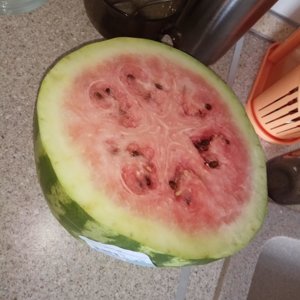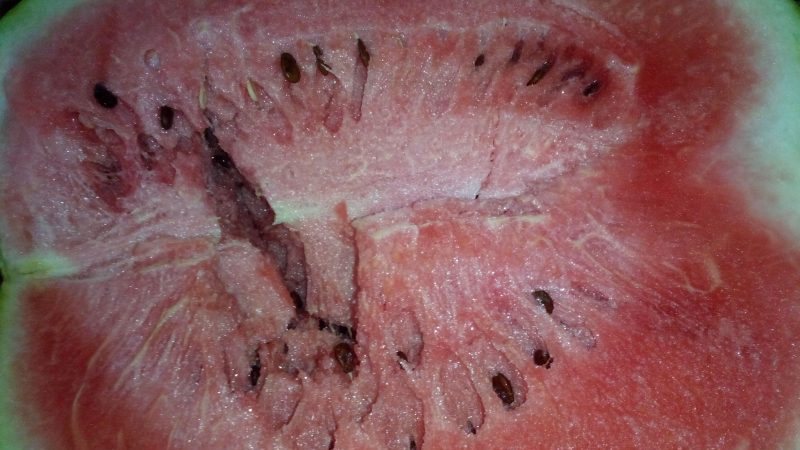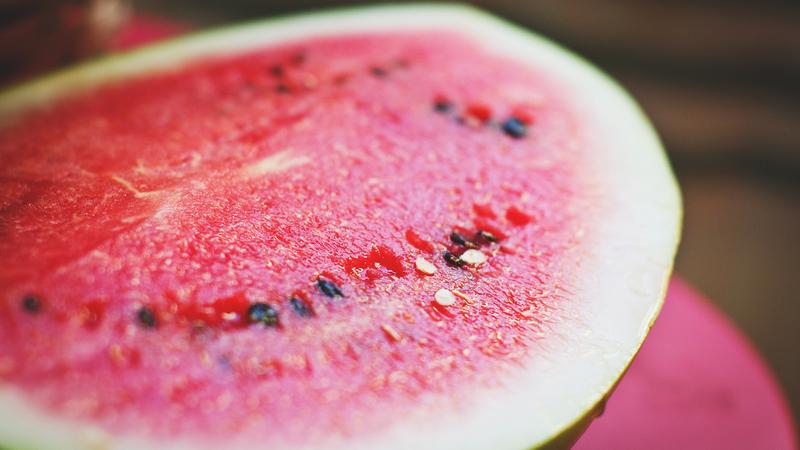What do white streaks in a watermelon mean and what other signs should alert you
Watermelon is a seasonal berry, its ripening period in nature begins in mid-August and lasts until the end of September. Unscrupulous farmers, wishing to speed up the process of growth and ripening of fruits, use nitrates to fertilize the soil, which in large doses are toxic to the human body.
The question arises, how to choose natural and ripe watermelon? The quality of the fruit can be determined by external signs such as color, smell, shape, peel. But special attention must be paid to the pulp. Watermelon can be loose, soft, smooth inside, with white or yellow veins, white or purple. Which one is unsuitable for eating, what the nitrate pulp looks like, why the streaks in the watermelon are white and what this means - read the article.
The content of the article
White streaks in watermelon - where do they come from
Initially, the watermelon pulp has a heart-shaped repetition in the form of thin light intertwining stripes that provide the fruit with nutrients. An excess of nitrates leads to a change in the appearance of the edible portion. They make the pulp bright red or even purple, sometimes white, smooth and even, and the veins thick, white or yellow.
Nitrates are salts of nitric acid that plants need to form chlorophyll, they cannot live without them. Plants take nitrogen from the soil, but to increase productivity, farmers additionally fertilize the land with nitrogen-containing nitrates.
At the beginning of growth, the fruit pulp of a watermelon accumulates nitrate substances for further nutrition, and by the time of ripening, most of them are spent to build their own cells. Berries that have been overly fertilized with nitrates accumulate these compounds in excess and become toxic to the human body.
Important. Unripe fruits of watermelon should not be eaten, as they contain a large amount of unused nitrogen-containing substances. The least nitrates are in ripe medium-sized fruits.
Reasons for the appearance of white streaks in a watermelon
Excessive doses of nitrogen fertilizers can provoke the formation of white streaks in the watermelon pulp. But this is not the only reason for their appearance. White spots can be the result of unbalanced plant nutrition: the use of nitrogen fertilizers without potash and phosphorus organic matter, untimely fertilization of the soil, irrational use of inorganic dressings.
Watermelons accumulate excess nitrates due to lack of light. Pale flesh will appear in fruits grown in a greenhouse under conditions of short daylight hours or in thickened crops.
The nitrate level in fruit pulp increases with improper storage. To avoid the formation and accumulation of nitrates, melons are laid clean and dry, checked for traces of damage by insects, mechanical damage. Optimal storage conditions are a dry, well-ventilated room without direct sunlight, with a low air temperature.
Is it possible to eat such a watermelon
Nitrates are found in every food, and in moderation can even be beneficial to the body... However, high doses are toxic, so foods containing them are unsuitable for eating. After eating poor quality berries weakness, dizziness, vomiting, nausea, diarrhea, chills, painful stomach cramps, fever occur.
Dysbiosis, dehydration of the body, renal and hepatic failure, and dysfunction of the digestive system are the undesirable consequences of food poisoning.
In other cases, an excess of nitrates can provoke hypoxia. Interacting with hemoglobin, they convert it into methemoglobin, which loses its ability to deliver oxygen to tissues and organs, which ultimately leads to oxygen starvation. Nitrates also adversely affect the functionality of the digestive system and increase the risk of cancer.
For reference... The nitrate content and the ability of the berry to absorb and store nitrate to some extent depends on varieties.
Other signs of a bad watermelon
The presence of high doses of nitrates in the fruit pulp can be determined by other signs: bitterness, loose pulp, white spots or a white tint of the edible part.
Loose pulp, watermelon like cotton wool

Loose flesh can be a normal option for overripe berries. Then it retains its density near the crust, and softens closer to the center. You can not eat fruits in which the edible part is loose, loose, porous, crumbly, while easily crushing with your fingers. Such a watermelon was stored incorrectly: in an open area, not protected from direct sunlight.
Bitterness
The bitter taste is due to several reasons:
- Long-term storage of berries in the wrong conditions. The shelf life of a whole ripe watermelon is limited to three months. Then the taste and structure of the pulp change.
- Damaged peel. Through the cracks, bacteria seep into the pulp, poison it with waste products, which makes the pulp bitter.
- Sometimes, for transportation and extension of shelf life, fruits are treated with gas - ethylene. Under its influence, the structure of the fruit pulp becomes fibrous and takes on a bitter taste.
White spots on watermelon
Fruit pulp of a heterogeneous color with individual white spots, a loose and soft structure is an indicator of a high nitrate content. This watermelon cannot be used.
White inside watermelon
Watermelon, white on the inside - an unusual variety or an unripe berry? There is a variety with an unusual color of fruit pulp, it is called "White Miracle". In this case, it is a varietal feature.
But more often the white color of the edible part indicates that the berry did not have time to ripen or stuffed with nitrates. White bloom on the surface of the peel, yellow streaks, white sunflower seeds, loose flesh with cracks and voids indicates that this is an unsuitable product for consumption.
Cavity inside
Flesh rupture occurs when the berry is overripe or growth stimulants were used during its cultivation.
Tips for choosing a good watermelon
It is possible to detect nitrate pulp only at home after cutting the fruit, so you need to pay attention to external indicators of quality and storage conditions.
Experts advise buying watermelons near the field where they grew, or in the market. Go around the point of sale located near the road. The berry has the properties of absorbing dust and harmful impurities, therefore such a watermelon becomes unusable, dangerous for the human body.
When buying a watermelon on the market, ask the seller to provide a certificate of the State Sanitary and Epidemiological Supervision or other document certifying quality. Pay attention to the storage conditions of the berries. The point of sale should be under a canopy to protect it from direct sunlight and precipitation, and the berry itself should be stored in special pallets with a height of at least 20 cm.
Ideally, the watermelon should be large, but not heavy, with an average weight of 6-10 kg. If you choose a large fruit, it is likely that it will be oversaturated with nitrates, and if it is small - that it has not yet had time to grow and ripen.

Other external signs of a ripe natural watermelon:
- dry stalk - a dried tail indicates that the watermelon is overripe or has been stored for a long time (a green stalk indicates that the berry has not reached ripeness);
- glossy top layer without matte finish with a pronounced striped pattern;
- small yellow earthen spot on the side (5-10 cm);
- makes a dull sound when tapped, crackles when squeezed;
- has no cuts, damage, traces of damage by insects, adhering dirt;
- in an unripe watermelon, it is easy to damage the skin with a fingernail - a herbal smell will appear and juice will be released.
Council. It is not recommended to buy a watermelon without a stalk, since in this case it is difficult to determine its ripeness.
Watermelons are classified by gender into male and female berries. They differ in the shape of the lower part and the size of the circle on it. Connoisseurs prefer to buy a girl-watermelon - it is more juicy, sweeter, and contains fewer seeds.
Conclusion
If the purchased watermelon meets all the external signs, and when cut, a friable, like cotton wool, pulp with yellow streaks, white spots, an unpleasant smell or taste is found, you cannot use such a watermelon - this is dangerous for health.
To minimize your risk of food poisoning and other side effects, don't buy watermelons before mid-August. If you buy them ahead of time, there is a high probability of getting a product containing an excess of nitrates.